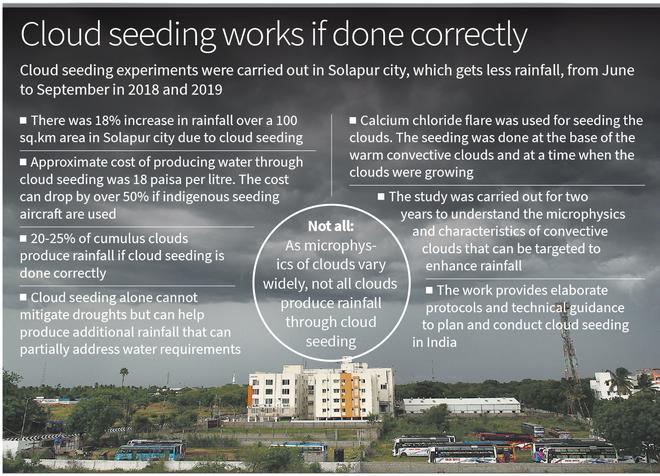A cloud seeding experiment carried out in Solapur city, which falls on the leeward side of the Western Ghats and hence gets low rainfall — 384 mm and 422 mm of total rainfall during the period June to September 2018 and 2019, respectively — was able to achieve 18% relative enhancement in rainfall, which is approximately 8.67mm more rainfall. The relative enhancement of accumulated rainfall was seen over two hours after seeding the clouds. In all, the total enhancement of water availability through cloud seeding experiments was 867 million litres. The results of the study were published recently in the journal Bulletin of the American Meteorological Society.
The experiment — Cloud Aerosol Interaction and Precipitation Enhancement Experiment (CAIPEEX phase-4) — was a scientific investigation conducted in Solapur city during the summer monsoon period of 2018 and 2019. The primary objective was to investigate the efficacy of hygroscopic seeding in deep convective clouds and to develop a cloud seeding protocol. The experiment used two aircraft for studying various cloud parameters and for seeding the clouds.

The study found that cloud seeding is an effective strategy for enhancing rainfall in a region under suitable conditions. A randomised seeding experiment was undertaken to study the effectiveness of cloud seeding in producing rainfall. In total 276 convective clouds were chosen, and 150 were seeded while the remaining 122 clouds were not seeded. “In our previous work we have found certain characteristics in a cloud such as the liquid water content in the cloud, the vertical motion in the cloud, which is an indicator of the growth of the cloud, will help inform us if the cloud will rain or not. Based on several criteria we know if a convective cloud has a potential to rain as all clouds cannot rain,” she says. Convective clouds with a depth of over one kilometre and likely to evolve into deep cumulus clouds were targeted.
“We must indicate that the availability of a large number of samples (150/122 seed/no-seed) is a testimony to the rainfall enhancement through hygroscopic seeding with the physical conditions set in CAIPEEX,” the authors write.
“The seeded clouds produced more rainfall than the unseeded clouds,” Dr. Thara Prabhakaran from the Indian Institute of Tropical Meteorology, Pune and the corresponding author of the paper tells The Hindu.
Calcium chloride flare was used for seeding the clouds. A cloud seeding flare releases these particles when triggered. The seeding was done at the base of the warm convective clouds and at a time when the clouds were in their growing stage so that the seed particles could enter the clouds with minimum dispersion. “The convective cloud bases are found at 500-1,500 metres altitude during the summer monsoon period and around 2,000 metres or more altitude during the monsoon break periods, which depends on the moisture content in the lower atmosphere,” Dr. Prabhakaran says. “Since the clouds are found at lower heights, the base of the convective clouds is warm, around 15 degrees C.”
“But cloud seeding alone cannot mitigate droughts but can help produce 18% more rainfall and partially address water requirements,” says Dr. M. Rajeevan, former secretary, Ministry of Earth Science, and a co-author of the paper. Undertaking cloud seeding as catchment-scale projects can possibly help in managing drought conditions.
“The study was carried for two years to first study and understand the microphysics and characteristics of convective clouds that can be targeted to enhance rainfall. The work provides elaborate protocols and technical guidance to plan and conduct cloud seeding in India,” he says. The two-year study has helped develop a high-resolution numerical model that can help stakeholders to identify target locations, clouds that can be seeded, and a suitable seeding strategy to enhance rainfall in an area.
One of the most important findings of the study was that not all cumulus clouds produce rainfall when cloud seeding is done. “We found 20-25% of cumulus clouds produce rainfall if cloud seeding is done correctly. The microphysics of clouds vary widely and so not all clouds produce rainfall through cloud seeding,” says Dr. Rajeevan.
“Though the relative enhancement of rainfall was 46% as measured by automatic rain gauges, the actual increase in rainfall over a 100 sq.km area was only 18%,” says Dr. Prabhakaran.
“We estimated the cost-benefit ratio and found the approximate cost of producing water through cloud seeding was 18 paisa per litre. It was a research experiment and so we hired two aircraft from outside India for seeding the clouds. The cost will drop by more than 50% if we use indigenous seeding aircraft,” says Dr. Prabhakaran.
In places like Solapur where water is supplied only once in three days, the availability of additional water through cloud seeding will be immensely beneficial.







